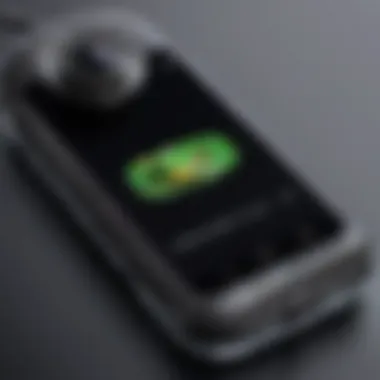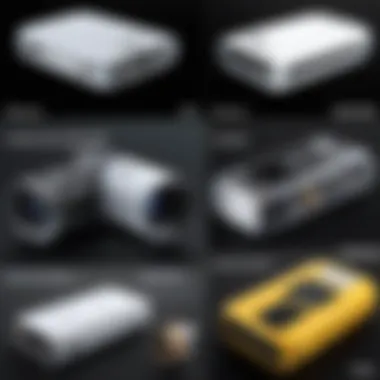Exploring the Snake Camera for Phone: A Comprehensive Guide


Intro
Snake cameras, also known as endoscopes, have emerged as fascinating tools for both photography enthusiasts and practical users. Their flexibility and ability to reach confined spaces set them apart in the imaging world. This guide will explore the features, uses, and installation methods of snake cameras designed for smartphones.
In a time when mobile photography has become highly sophisticated, snake cameras add a unique dimension. They are particularly useful for inspecting hard-to-reach areas, allowing users to document and assess situations that would otherwise be difficult to capture. As this article unfolds, we will delve into the dynamics of snake cameras, from their technical attributes to real-world applications and challenges.
Foreword to Snake Cameras
The emergence of snake cameras marks a significant milestone in imaging technology, particularly for mobile devices. These flexible, elongated cameras designed for smartphones offer practical solutions across various fields. They are gaining attention for their unique ability to view hard-to-reach places. Understanding this technology is essential for tech enthusiasts, casual consumers, and professionals who are seeking effective tools for inspection or creative pursuits.
What is a Snake Camera?
A snake camera, also known as a borescope or endoscope, consists of a long, flexible tube with a camera attached to one end. The camera captures images and videos, allowing users to view inaccessible areas directly on their smartphone screens. Typically, these devices are used for inspection tasks, such as checking plumbing, HVAC systems, or automotive components. The integration with smartphones enhances the experience by providing a convenient display and various apps for image management.
The primary appeal of a snake camera lies in its versatility. Users can maneuver it around corners and through tight spaces without the need for significant disassembly. This makes its applications valuable not only for DIY enthusiasts but also for professionals in maintenance, repair, and even creative fields.
Historical Context and Evolution
The history of snake cameras is intertwined with advancements in imaging technologies. Originally, borescopes were large and cumbersome devices used primarily in industrial settings. Over time, with the miniaturization of cameras and improvements in optical design, these devices became smaller and more accessible.
In the early 2000s, the development of smartphones opened new avenues for snake cameras. With the ability to process images efficiently, smartphones provided an ideal platform for users to interact with the imagery captured by these cameras. Early snake cameras required external monitors or computers, limiting their usability. However, the integration with smartphones revolutionized how users performed inspections and captured footage.
Today, snake cameras come equipped with a variety of features like adjustable lighting, extended cable lengths, and high-resolution imaging. As technology continues to evolve, we can anticipate further enhancements that will make these devices even more effective and user-friendly.
Technical Specifications
Understanding the technical specifications of snake cameras is crucial for making informed decisions regarding their use with smartphones. These specifications can dictate overall performance, usability, and suitability for specific applications. Factors such as camera resolution, cable length, flexibility, and lighting options are essential components that directly impact the effectiveness of snake cameras. Delving into these aspects provides potential users with insights that can enhance both their photographic and inspection tasks.
Camera Resolution and Quality
Camera resolution significantly affects the clarity and detail of images captured through snake cameras. A higher resolution implies that more pixels are available to render an image, resulting in greater clarity, especially when inspecting hard-to-reach areas. Most snake cameras for phones offer resolutions ranging from 640 x 480 pixels to 1920 x 1080 pixels or higher.
For practical applications, consider the following:
- Low resolutions: These may suffice for basic inspections but can miss fine details.
- High resolutions: Better for capturing intricate components, which is vital for both technical inspections and creative photography.
In addition to resolution, the quality of the camera sensor also plays a role. A high-quality sensor can capture more light, thereby enhancing overall image performance in various lighting conditions, which becomes important when using the camera in darker settings.
Cable Length and Flexibility
Another key aspect of snake cameras is cable length and flexibility. A longer cable provides greater reach, allowing users to navigate through tight spaces more effectively. However, length alone is not sufficient; flexibility is equally important. If the cable is rigid, it may be difficult to maneuver in confined areas.
Factors to consider include:
- Standard lengths: Most snake cameras come with cables between 2 to 5 meters, which offer a decent range for most tasks.
- Flexibility: Look for cameras with cables that maintain their shape while bending. This flexibility allows potential access to corners and tight spaces where traditional cameras cannot reach.
Having an understanding of these elements ensures that users can select a snake camera that best fits their specific needs, whether it's for inspection or creative use.


Lighting Options and Features
Good lighting is crucial for effective imaging, particularly in challenging environments. Many snake cameras include built-in LED lights that illuminate dark areas, making visibility more manageable. Adjustable lighting intensity can further enhance usability, allowing users to modify the brightness based on their environment.
Key features to look for include:
- Built-in LED lights: Essential for capturing clear images in dark areas.
- Adjustable brightness: Improves image quality and helps avoid glare or overexposure.
Compatibility and Requirements
Understanding the compatibility and requirements of snake cameras for smartphones is essential for maximizing their utility. Snake cameras, also known as borescope cameras, offer unique viewing angles and are useful for inspecting hard-to-reach areas. Knowing what devices work well with these cameras can save time and enhance the user experience.
Smartphone Compatibility
Smartphone compatibility is a critical factor when it comes to using snake cameras. Most snake cameras are designed to connect with popular smartphone brands like Apple and Samsung. However, not all models will work seamlessly across various devices.
Key considerations include:
- Operating System: Check if your device runs on iOS or Android, as the camera’s app might only support one of these systems.
- Connectivity: Some snake cameras utilize USB connections, while others might operate via Wi-Fi or Bluetooth. Ensure your phone has the necessary ports or wireless capabilities to link with the camera.
- Physical Size: The snake camera connector should fit securely into the smartphone socket. Some models might require adaptors, adding complications to the setup.
Everyone should verify compatibility before making a purchase. This can prevent disappointment during use. Users can often find compatibility information on manufacturer websites or product packaging.
Application Requirements
Application requirements also play a significant role in the effective use of snake cameras.
- Software Installation: Most snake cameras come with specific apps for efficient functionality. Users need to install these apps from Google Play Store or Apple App Store to control camera settings and view footage.
- Permissions: The app may require permissions to access the smartphone camera and storage. Users should review and agree to these settings to ensure proper operation.
- Device Specifications: Some advanced features, like high-definition recording, might hinge on having a recent smartphone model with adequate processing power and memory. Early smartphones may struggle to handle modern applications effectively.
It is advisable to consult the user manual for both the camera and smartphone for detailed steps and recommendations. This clear understanding of requirements enhances the overall user experience and ensures smooth operation.
Compatibility and requirements are not merely technical specifications; they guide the user's journey in achieving optimal results with snake cameras.
Installation Process
The installation process for a snake camera plays a crucial role in maximizing its potential and functionality. A well-executed installation not only enhances user experience but also ensures that the device performs optimally. Understanding how to properly set up and configure the camera is essential, as this directly impacts the quality of the images and videos captured. This section explores the key steps in the installation process, focusing on the initial setup and configuration, as well as connecting the camera to your smartphone.
Initial Setup and Configuration
Setting up a snake camera involves several steps to ensure it functions as intended. The first step typically is unpacking the device carefully to avoid damage. Inside the package, you should find the snake camera itself, cables, and possibly an instruction manual.
Step-by-step Process:
- Charge the Camera: If the snake camera has a battery, make sure it is fully charged. Connect it to an appropriate power source using the provided charger.
- Download the Required App: Most snake cameras require a specific app to operate. Check the included documentation for the app's name. Download it from Google Play or the Apple App Store.
- Review Settings in the App: Open the app and review the settings. Adjust the resolution, brightness, or any other preferences you might have.
- Check for Updates: Ensure the app is updated to the latest version for optimal performance.
It is important to follow these steps meticulously as each one sets the foundation for camera operation. Ensuring that the camera is charged and the app is set reduces the likelihood of functionality issues later on.
Connecting the Camera to Your Phone
Connecting the snake camera to your smartphone is straightforward, yet it requires attention to detail. Properly establishing this connection is crucial for a seamless user experience.


Here are the steps to connect the camera:
- Turn On the Camera: Ensure that the camera is powered on by switch it on. LEDs usually indicate that the camera is operational.
- Use Correct Connection Method: Depending on the model, you may connect via USB or Wi-Fi. Quickly consult the user manual for specific instructions related to your device.
- Open the App: Launch the app on your smartphone that corresponds to the snake camera. Follow the on-screen prompts for initial setup.
- Pair the Devices: If using a wireless connection, ensure that the smartphone's Bluetooth or Wi-Fi is enabled. Follow the instructions in the app to pair it with the snake camera.
- Test the Connection: Once connected, test if the app displays the camera feed. This step is key to ensuring that everything is working correctly.
Applications of Snake Cameras
The applications of snake cameras are vast and varied, serving multiple purposes across different fields. Its significance lies not just in its innovative design but also in the problem-solving capabilities it provides. This article segment will dive into the practical uses of snake cameras, discussing their benefits and considerations that come with them.
Inspection and Repairs
Snake cameras are particularly useful in inspection and repair tasks. Their slender, flexible design allows users to access narrow spaces that regular cameras cannot reach. This feature is crucial in various industries such as plumbing, automotive, and electrical repairs.
Using a snake camera, technicians can quickly diagnose issues in pipes, engines, and electrical panels. For example, a plumber can navigate through tight pipe bends to locate clogs, while an electrician can inspect wiring in cramped spaces. This reduces the need for invasive procedures, thereby saving time and potential repair costs.
Additionally, snake cameras can provide real-time video feeds, enabling technicians to make informed decisions on site. This capability not only enhances efficiency but also boosts the quality of service provided. Clients benefit as they receive prompt and informed actions rather than spending extended periods waiting for repairs.
Home and Office Use Cases
In households and office environments, snake cameras find application in a variety of scenarios. They can be used for simple tasks like inspecting electrical outlets or smoke detectors, where visibility is limited. Homeowners can easily check for signs of damage or wear and tear without the need for costly renovations or professional help.
Moreover, snake cameras are valuable for routine maintenance. For instance, inspecting HVAC systems can lead to early detection of issues before they escalate into severe problems. Many workplaces can leverage snake cameras to assess equipment functionalities and detect failures before they result in operational downtimes.
One distinct advantage of snake cameras in these settings is their portability. They can be easily transported and stored, ready for use whenever needed. This convenience appeals to homeowners and office managers alike, making routine inspections less daunting.
Creative Photography and Videography
On a different note, snake cameras can also enhance creative photography and videography. They allow photography enthusiasts to explore new angles and perspectives that traditional cameras may find challenging to capture. For instance, the ability to maneuver the camera into tight spaces can result in unique shots that add variety and creativity to visual storytelling.
Similarly, videographers can use snake cameras for unique content creation. Imagine capturing behind-the-scenes footage in confined spaces or hard-to-reach locations that standard equipment cannot penetrate. This ability to explore untouched perspectives can elevate a project’s narrative.
Users need to experiment with lighting and settings for the best results. Often, snake cameras come equipped with built-in lights, facilitating better capture even in dimly lit areas. Through careful use of technical features, photographers and videographers can maximize the potential of snake cameras.
In summary, the applications of snake cameras extend beyond mere inspection work. They are immensely beneficial in home maintenance, office settings, and creative endeavors, making them a versatile tool.
User Experience and Feedback
User experience is a pivotal aspect in understanding the adoption and effectiveness of snake cameras for phones. Feedback from users provides a real-world perspective on the functionality, ease of use, and overall value of these devices. Every feedback informs potential buyers and manufacturers alike about the strengths and weaknesses found in various models. In today’s highly competitive market, knowing what users think enhances decision-making and helps improve future iterations of products.
Advantages of Using Snake Cameras
- Versatile Applications: Snake cameras are not just useful for one specific task. Users often find them beneficial for inspections in hard-to-reach places or even for creative photography projects. This versatility allows consumers to invest in a tool that serves multiple purposes.
- Enhanced Visibility: The design typically includes a flexible cable with a small camera at the end. This allows users to navigate tight spaces, providing a clear view where traditional cameras may fail. The ability to see areas such as plumbing or behind walls is invaluable for both professionals and DIY enthusiasts.
- Affordability: Compared to other high-tech imaging solutions, snake cameras are often more budget-friendly. Many models provide decent quality without breaking the bank, making them accessible for a broader audience.
- Ease of Use: Most models connect directly to smartphones with minimal setup needed. Users can download applications that simplify operations, allowing anyone to become a photographer or inspector with little technical knowledge.
Common Issues and Limitations
While snake cameras offer distinct advantages, they also have their share of challenges:
- Limited Resolution: Many snake cameras may not provide high-resolution images, especially in low-light conditions. Users might find that the quality does not meet professional standards.
- Cable Durability: The cables can be fragile and may wear out over time, especially with frequent use. Users have to be cautious and avoid over-bending or pulling the cable excessively.
- Compatibility Issues: Some models may not be compatible with all smartphone types. If a user has an older phone or a less common model, it may not work seamlessly, leading to frustration.
- Battery Dependency: Depending on the specific model, battery life can be a concern. Users should check reviews to understand how long a snake camera lasts on a single charge.


Understanding both the advantages and limitations of snake cameras can greatly enhance a user’s experience, ensuring informed decisions are made during purchasing and usage.
Market Trends and Recommendations
Understanding market trends related to snake cameras for phones is essential for both consumers and industry stakeholders. As technology rapidly evolves, snake cameras have become increasingly accessible and versatile. They are now marketed not just for professional uses but also for personal and creative applications. Trends indicate that users are searching for innovative features while balancing functionality and cost-effectiveness. This section highlights essential elements for potential buyers and offers insights for manufacturers as they develop new products.
Popular Brands and Products
Several brands stand out in the snake camera market, offering various models tailored for distinct user requirements. Notable brands include:
- Depstech: Known for its high-quality resolution and durable design, making it suitable for professional inspections.
- Teslong: This brand focuses on versatility, offering options with various cable lengths and camera resolutions.
- BlueFire: Popular among casual users, BlueFire cameras are user-friendly and often come with additional accessories for enhanced usability.
These brands have adapted their products to meet increasing consumer expectations. Features like enhanced image quality, longer cable, and compatibility with various smartphones have made them favorites among tech enthusiasts. Clients should assess their specific needs, whether for home repairs or for creative photography, as different brands offer varying strengths.
Price Range Analysis
In the snake camera market, prices can vary significantly based on features, brand reputation, and technological advancements. Generally, you can expect the following range:
- Entry-Level Models: Priced between $20 to $50, these cameras are suitable for casual users interested in basic inspection tasks.
- Mid-Range Models: Ranging from $50 to $150, these models often include better resolution and more robust cable options, appealing to hobbyists and professionals alike.
- High-End Models: These typically cost $150 and above, targeting professionals requiring advanced capabilities for intricate inspections.
When purchasing, it's vital to consider not just the price but the value offered. Assessing customer reviews and product specifications can help. Interestingly, many users find that spending a little more can lead to a substantially better experience and longevity. Also, keep an eye on seasonal sales and promotions as they can provide significant savings.
Future Developments
The future of snake cameras for phones is an intriguing area of exploration. As technology progresses at a rapid pace, snake cameras are increasingly becoming more sophisticated. Understanding future developments is crucial for users who wish to harness the full potential of these devices. Notably, advancements in technology can introduce enhancements in image quality, flexibility, and overall functionality. Keeping abreast of these changes ensures that consumers can make educated choices regarding their investments in imaging tools.
Technological Advancements
Technological advancements are one of the primary drivers of innovation in snake cameras. Ongoing improvements in sensor technology contribute to higher resolution images, which is essential for detailed inspections and creative photography. Enhanced sensors can operate in varying lighting conditions, providing clearer images without overexposing highlights. This is particularly beneficial for users needing to inspect tight spaces or darker areas, such as plumbing or electrical work.
Additionally, wireless technology is on the rise within mobile devices. Future snake cameras may rely on Bluetooth or Wi-Fi for connectivity. This shift would eliminate the need for physical connection to the phone, making it more user-friendly. Some snake cameras already employ this wireless feature, but we can expect improvements in range, battery life, and connection stability.
Moreover, as processing power in smartphones continues to grow, compatibility with advanced imaging features such as real-time image processing becomes feasible. Future developments might enable users to apply filters, edit images, or even utilize augmented reality elements directly on their devices. This bridges the gap between functionality and creativity, opening new avenues for application.
Potential New Applications
New applications for snake cameras are also on the horizon. As industries evolve, so do their demands. For example, emergency services may benefit from enhanced snake camera technology. The ability to inspect hazardous situations without direct exposure can save lives. Detailed imaging could guide first responders through potentially dangerous environments, improving their situational awareness.
In the realm of education, snake cameras could be integrated into various learning environments. Students and educators can use these devices for practical demonstrations in science labs or during fieldwork. It could allow for unique observation techniques, promoting an interactive learning experience.
Moreover, as home automation technologies become more prevalent, snake cameras may play a crucial role in smart homes. Users could integrate these cameras into their home monitoring systems, helping them to manage maintenance tasks or observe remote areas of their property.
It is clear that snake cameras are moving toward a multifaceted future. Staying informed about these advancements ensures that users can adapt and utilize the technology to its fullest potential.
Epilogue
The conclusion of this article shines a light on the significance of snake cameras for smartphones in various contexts. These devices enhance users' capabilities, allowing for diverse applications ranging from home inspections to creative photography. Snake cameras offer not only accessibility but also versatility, bridging the gap between casual exploration and professional use.
In this digital age, as technology continues to evolve, the importance of snake cameras becomes even more prominent. They provide a unique solution for tasks that often require intricate maneuvering and detailed visualization in tight spaces. Thus, understanding their functionality and the benefits of integrating such devices with smartphones is crucial.
Summary of Key Points
- Functionality: Snake cameras provide a unique imaging solution using a flexible design, allowing users to navigate around obstacles with ease.
- Applications: From plumbing inspections to artistic ventures, snake cameras serve multiple purposes for both casual and professional users.
- Technological Integration: The compatibility of these cameras with smartphones simplifies their use, making advanced imaging accessible to a wider audience.
- Limitations: While snake cameras have many advantages, it is essential to recognize the limitations, including resolution constraints in some models and potential connectivity issues.
- Future Potential: Ongoing technological advancements suggest that snake cameras will continue to evolve, enhancing capability and usability in various fields, including medicine and utility services.
In summary, snake cameras represent an important intersection of technology and practicality, making them a valuable addition to the toolkit of anyone interested in exploration or inspection tasks.



